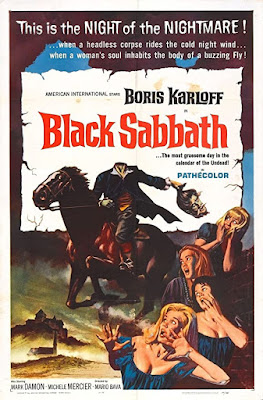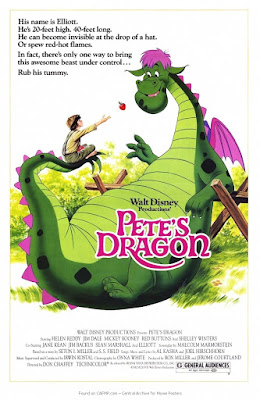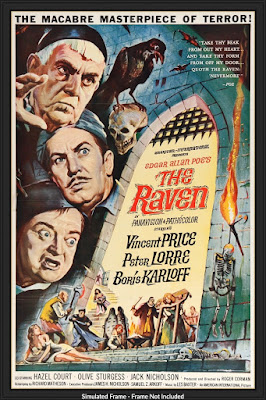Black Sabbath (1963)
Black Sabbath (AKA: I Tre Volti Della Paura) (1963)
In 1963 Italy's master of horror Mario Bava teamed up with horror film actor and legend Boris Karloff to create a low budget horror anthology, which would go on to fail, but also whose name would be used by one of the bands that created heavy metal music, Black Sabbath. Black Sabbath is a horror anthology film comprised of three segments: The Drop Of Water; The Telephone; and The Wurdulak. Depending on the version that you have of the film the order of the stories might be different. Also if you have the Italian film, you have the better version of the film, as the American version was changed to suit the conservative tastes of American viewers. The biggest changes were made to the segment The Telephone, which in the American version is the weakest of the stories. In the original Italian version, there was a lesbian love subplot, and a subplot of prostitution, which were taboos that American viewers couldn't handle at that point. The American version also cut most of the violence from the film, again because it would offend American viewers. The American version also refilmed the wrap around segments with Boris Karloff, that act to introduce the stories. Though Black Sabbath was initially a failure, critical reception and appreciation of the film grew over the years, and it became a cult classic, and has inspired directors like Quentin Tarantino, who claimed that originally with his film Pulp Fiction that he wanted do for the crime film genre what Black Sabbath did for the horror film genre. Black Sabbath is a great example of how a film that was dismissed when it was released, can end up being an important film later. To me there are certain things about the look of this film, that I feel are iconic and ground breaking, and that the film has this amazing dark artistic look to it, and that overall it was an absolutely beautiful classic horror film, even in its watered down American release. Black Sabbath was directed and co-written by Mario Bava. The screenplays were written by Marcello Fondato, Alberto Bevilacqua, and Mario Bava. Though the stories had original elements they were partly inspired by the works of Ican Chekov, F.G. Snyder, and Aleksei Tolstoy. The film was developed and distributed for American audiences by Allied Artists in 1963, though Warner Bros handled the Italian distribution, and The Rank Organisation handled the French distribution. The film was a significant box office failure, making back only about half of its budget costs. Part of this might be attributed to bad press after a woman supposedly had a miscarriage while watching it in the theater, but also due to the failure of aging Boris Karloff to be a draw for the younger adult demographic.
Black Sabbath is an anthology of three short horror films. For the American version the first short is The Drop Of Water, which stars Jacqueline Pierreux as Nurse Helen Chester, Milly Monti as The Maid. This segment is about an old woman who dies of a heart attack during a seance, and as the nurse is dressing her body, she steals the old woman's ring. But sometimes the dead don't like their things taken, as weird occurances start to happen to the Nurse when she returns home. This story is loosely based on Ivan Chekov's "Dalle Tre Alle Tre E Mezzo" (Between Three and Three-Thirty), though at one point Mario Bava claimed that the story was his own original work. This segment features one of the most iconic visuals in the film, with the grotesque appearance of the face of the dead woman.
The short, The Telephone was one of Bava's first attempts to make a giallo film. The short stars Michele Mercier as Rosy, Lydia Alfonsi as Mary, and Milo Quesada as Frank. The short is about Rosy who keeps receiving strange repeated phone calls from a man who identifies himself as Frank, and she calls her friend Mary to come over to comfort her. In the Italian version Rosy and Mary are "call-girls" and Frank is their former pimp who has recently escaped from prison. And Rosy and Mary engage in a lesbian love affair. Almost all of that was cut from the American version, which ends up making it much more of a supernatural horror than the original Italian version. Because of the heavy edits and changes from the Italian to the American version The Telephone ends up being the weakest of the three short stories in the film. The Telephone is loosely based on short story of the same name by F.G. Snyder.
Black Sabbath is an anthology of three short horror films. For the American version the first short is The Drop Of Water, which stars Jacqueline Pierreux as Nurse Helen Chester, Milly Monti as The Maid. This segment is about an old woman who dies of a heart attack during a seance, and as the nurse is dressing her body, she steals the old woman's ring. But sometimes the dead don't like their things taken, as weird occurances start to happen to the Nurse when she returns home. This story is loosely based on Ivan Chekov's "Dalle Tre Alle Tre E Mezzo" (Between Three and Three-Thirty), though at one point Mario Bava claimed that the story was his own original work. This segment features one of the most iconic visuals in the film, with the grotesque appearance of the face of the dead woman.
The short, The Telephone was one of Bava's first attempts to make a giallo film. The short stars Michele Mercier as Rosy, Lydia Alfonsi as Mary, and Milo Quesada as Frank. The short is about Rosy who keeps receiving strange repeated phone calls from a man who identifies himself as Frank, and she calls her friend Mary to come over to comfort her. In the Italian version Rosy and Mary are "call-girls" and Frank is their former pimp who has recently escaped from prison. And Rosy and Mary engage in a lesbian love affair. Almost all of that was cut from the American version, which ends up making it much more of a supernatural horror than the original Italian version. Because of the heavy edits and changes from the Italian to the American version The Telephone ends up being the weakest of the three short stories in the film. The Telephone is loosely based on short story of the same name by F.G. Snyder.
The third short film (in the American version) is The Wurdulak, which is loosely inspired by Semya Vurdalak (The Family Of the Vourdalak) by Aleksey Tolstoy, with elements also inspired by Fear by Guy de Maupassant, and Dracula by Bram Stoker. The Wurdulak stars Mark Damon as Vladimir D'urfe, Glauco Onorato as Giorgio, Rika Dialina as Giorgio's wife, Massimo Righi as Giorgio's brother Pietro, Susy Andersen as Giorgio's sister Sdenka, and Boris Karloff as Gorca that patriarch of the family. The Wurdulak is a classic vampire story, and an effective classic horror story. This segment is a great classic horror, and stands out from the rest of the film, as being more of a classic horror story, where the other two have more of a contemporary feel to them, which honestly is part of why the film Black Sabbath works, there is a classic tale of horror like The Wurdulak, a early 1900's tale like The Drop Of Water, and then a contemporary horror story like The Telephone, and they work together to create a "horror through the years" type effect. Also one other note on The Wurdulak, there is a line of dialogue, not sure if it is a translation issue, or just that language has evolved since it was written, where Boris Karloff's character says "Can't a grandfather fondle his grandson?", which now sounds quite inappropriate.
Overall, Black Sabbath is a great cult classic. Though there are definitely better films, I still feel like Black Sabbath is a must see film. The film is beautifully artistic, horrifying grotesque, well written, and features three shorts about ghosts and vampires. Each segment is well done, especially considering that it is a low budget Italian horror film from 1963. It is also nice getting to see Boris Karloff in colour, and as one of his later career films, Black Sabbath stands out as a great one. If you have not yet seen this classic horror film, I highly recommend checking it out, it is a great and terrifying classic horror film, and I love the introduction segments with Boris Karloff, which remind me slightly of the television show The Veil where Karloff introduced each episode, though these have a great style and flair to them. If you come across a copy of Black Sabbath, definitely pick it up, it is a film that should be a part of very film collector's library. Also since the film is in public domain, it is pretty easy to find, and can often be find in public domain horror DVD collections.
Overall, Black Sabbath is a great cult classic. Though there are definitely better films, I still feel like Black Sabbath is a must see film. The film is beautifully artistic, horrifying grotesque, well written, and features three shorts about ghosts and vampires. Each segment is well done, especially considering that it is a low budget Italian horror film from 1963. It is also nice getting to see Boris Karloff in colour, and as one of his later career films, Black Sabbath stands out as a great one. If you have not yet seen this classic horror film, I highly recommend checking it out, it is a great and terrifying classic horror film, and I love the introduction segments with Boris Karloff, which remind me slightly of the television show The Veil where Karloff introduced each episode, though these have a great style and flair to them. If you come across a copy of Black Sabbath, definitely pick it up, it is a film that should be a part of very film collector's library. Also since the film is in public domain, it is pretty easy to find, and can often be find in public domain horror DVD collections.






Comments
Post a Comment